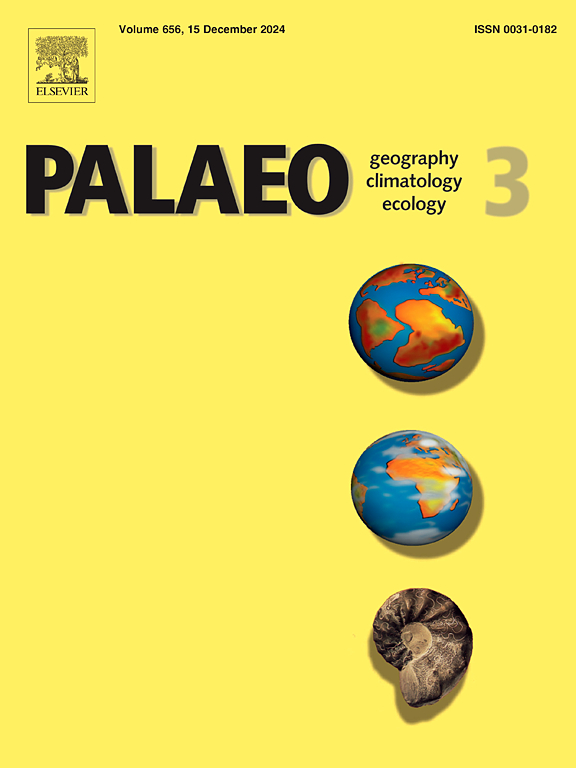季风和深海对孟加拉湾东南部有机碳埋藏的控制
IF 2.7
2区 地球科学
Q2 GEOGRAPHY, PHYSICAL
Palaeogeography, Palaeoclimatology, Palaeoecology
Pub Date : 2025-07-24
DOI:10.1016/j.palaeo.2025.113163
引用次数: 0
摘要
边缘海在吸收人为CO2方面发挥着关键作用,但其冰期-间冰期碳埋藏的驱动因素仍然存在争议,特别是在深水中。孟加拉湾是全球碳固存的热点地区,其东南区域以海洋有机碳为主,并受到深海水域的入侵。利用总有机碳含量(TOC)和同位素(δ13Corg)重建末次盛冰期(LGM)以来的有机碳埋藏历史,并利用自生钕同位素和铀含量、生物源钡含量等多代记录重建古生产力、氧化还原条件和底水动力学,探讨其控制机制。有机碳积累速率在LGM (0.75% TOC)期间达到峰值;200 mg cm−2 kyr−1),由于季风驱动的垂直混合增强和缺氧保存,然后在全新世下降到最小值(0.21% TOC;27 mg cm−2 kyr−1),增强底水氧合。这些变化支持“混合氧合”机制:季风强度控制地表生产力和颗粒输出,而深水入侵调节氧气水平和碳保存效率。研究结果强调了表层-深海耦合过程在调节海洋碳汇中的关键作用,有助于提高对未来全球变暖和海洋缺氧加剧下边缘海-海过渡带有机碳埋藏过程的认识和预测。本文章由计算机程序翻译,如有差异,请以英文原文为准。
Monsoon and deep ocean control of organic carbon burial in the southeastern Bay of Bengal
Marginal seas play a key role in absorbing anthropogenic CO2, yet drivers of their glacial-interglacial carbon burial remain controversial, especially in deep water. The Bay of Bengal—a global carbon sequestration hotspot—exhibits unresolved spatial heterogeneity, with the southeastern region dominated by marine organic carbon and invaded by deep-ocean waters. Here, we reconstruct organic carbon burial history since the Last Glacial Maximum (LGM) using total organic carbon content (TOC) and isotopes (δ13Corg), and discuss their controlling mechanisms by reconstructing paleoproductivity, redox condition and bottom water dynamics using multi-proxy records (authigenic neodymium isotopes and uranium content, biogenic barium content). The organic carbon accumulation rate peaked during the LGM (0.75 % TOC; 200 mg cm−2 kyr−1) due to enhanced monsoon-driven vertical mixing and oxygen-depleted preservation, then declined to minimal values in the Holocene (0.21 % TOC; 27 mg cm−2 kyr−1) with enhanced bottom-water oxygenation. These shifts support a “mixing‑oxygenation” mechanism: monsoon intensity governs surface productivity and particle export, while deep-water intrusions regulate oxygen levels and the efficiency of carbon preservation. Our findings highlight the critical role of coupled surface-deep ocean processes in regulating ocean carbon sinks, and contribute to improved understanding and prediction of organic carbon burial processes in marginal sea-ocean transition zones under future global warming and intensified oceanic hypoxia.
求助全文
通过发布文献求助,成功后即可免费获取论文全文。
去求助
来源期刊
CiteScore
5.90
自引率
10.00%
发文量
398
审稿时长
3.8 months
期刊介绍:
Palaeogeography, Palaeoclimatology, Palaeoecology is an international medium for the publication of high quality and multidisciplinary, original studies and comprehensive reviews in the field of palaeo-environmental geology. The journal aims at bringing together data with global implications from research in the many different disciplines involved in palaeo-environmental investigations.
By cutting across the boundaries of established sciences, it provides an interdisciplinary forum where issues of general interest can be discussed.

 求助内容:
求助内容: 应助结果提醒方式:
应助结果提醒方式:


